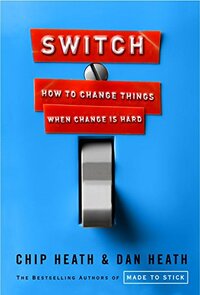Take a photo of a barcode or cover
AWESOME book. So much information in here and all of it is useful. It goes into the many reasons why change is so difficult- whether its on a personal or professional level. The authors give a lot of examples, tips, ideas, and more to make change easier. Highly recommend.
I really liked it, and I don't care if it is written simply and populist--that is the point. It contains good, illuminating stories, and clear ideas, as you would expect from the "Made to Stick" guys.
The advice on how to turn good intentions into lasting change is compelling.
The advice on how to turn good intentions into lasting change is compelling.
Pretty darn good.
I especially liked one of the ideas near the front of the book - find the bright spot. Stop analyzing failure; find out why things that worked did.
I especially liked one of the ideas near the front of the book - find the bright spot. Stop analyzing failure; find out why things that worked did.
Good book, simple concepts but very usable. Not talking down or over anyone's head. Great practical examples to use. Well written!
informative
medium-paced
There are some interesting ideas in here to make change occur at both a personal and organisational level but a simple idea that could have been condensed into fifty pages or so is stretched out to three hundred or so and I felt bored and worn out by the end and was glad to finish.
I'm reading this as it is a recommended book on a course I am doing at the moment and it suffers, like most business literature written by Americans this century in that the ethics and values of the book are pretty gross and the authors come across as especially dislikeable. I shouldn't be surprised, that much business literature reflects the grossness of corporate America but it's especially grating reading this from a position of empathy for other humans and animals.
The book drips with white saviourism - there are examples of 'a guy with no knowledge of the Vietnamese language solves malnutrition in a village' and another, 'goes to Tanzania and makes the society laugh at wealthy men who sexually exploit young girls and women'. Many of the examples portray getting people to change in relationships (always married and always heterosexual) and the tone is so incredibly patronising to women, trying to 'tap into' women's concerns in marriage - you know, 'how to get your husband to pick his dirty underwear up off the floor' and 'praise the guy if he remembers your birthday'. My overwhelming feeling reading the book was the authors (two brothers) are incredibly dismissive of women (the way they talk about their wives is cringe inducing). It's also hilarious that, like a lot of American business literature they cannot help but sneak god into everything - in a section about reinforcing good habits they put hygiene and praying in the same sentence!
Where the book fails significantly is that they have a basic analogy for delivering change and they use examples throughout the book to prove that they work - except that they don't prove anything. The book is littered with 'our point is 'x' and here is a case study that proves 'x' and yet there is no real evidence (even with the extensive notes section) that the thing they said happened, happened because of the theory. For instance the book makes claims about encouraging people to change the cow's milk they buy had an impact on obesity - yet obesity has a range of complex factors (and the food you eat is a surprisingly small factor. There is also an example that was so offensive it's untrue which suggests 'the way you get a monkey to ride a skateboard is to give it lots of mango, and anyway animal trainers aren't cruel anymore'. I'm sorry, but that shows absolutely no awareness of how animals are treated in captivity and how they respond to stimulus outside their natural environment. Performing animals is an incredibly cruel industry and it says much about the values of the authors in trying to prove their point that they miss this, thinking people are motivated by treats and praise. Which ignores what really motivates us to get stuff done.
So the book ignores complexity. It also comes across as incredibly manipulative from a behavioural science point of view. The whole book is about getting other people to do what YOU want. Whilst I can see this appeal to leadership cultures, and I can also see the appeal to personal change it's quite troubling just how manipulative the book is. It also doesn't examine how to know that your change is the right thing to do, how to check if it's right once you've started. In many respects it is quite a dangerous book - because the tips in this book can be used by the worst human beings with power to get what they want. The lack of awareness of what change is and what it does is startling. But it's okay - if you're a powerful person and you want to make a change this book will help you. The saddest thing is that the book essentially treats the recipients of change as passive, and like animals (from a human-centric perspective of animals being less than).
Which brings me to the premise of the book - that change is like 'riding an elephant'. You need to;
1) Direct the Rider
2) Motivate the Elephant and...
3) Shape the Path
The book suggests that the 'Rider' is our rational part of the brain. It is logical, it deals with facts and it likes to plan. The book suggests that we can over-analyze and that leads to inertia and not doing things. The 'Elephant' is our emotional side of the brain, and is the part of our brain that procrastinates and gives up, but also gives us energy to do so. I can follow this analogy that we can often write a factual business case but unless it appeals to our emotions and our reason for being it isn't going to make things happen. 'Shaping the Path' is essentially making things as easy as possible to get to one's destination. All of these make sense if I was thinking about a personal change, but fall down a little when it comes to change with others. Even the analogy that an elephant only lets people ride them is because it's emotions are appealed to 'because it's so big it wouldn't do it if it didn't want to' - that's so incredibly wrong because elephants ride because they have been psychologically crushed and have been treated cruelly since snatched away from their parents.
That said, I do get that our emotional sides override our rational sides and yet it is our emotional side where we get our drive from. The book states three problems generally occur in change and they relate to the three themes
'What looks like a people problem is often a situation problem'
'What looks like laziness is often exhaustion'.
'What looks like resistance is often a clarity issue'
In 'Direct the Rider' the book suggests we need to;
1) Follow the bright spots - find good practice, accentuate it and promote it
2) Script the critical moves - identify the critical actions people must take
3) Give direction to the rider - have a clear goal in mind, what success looks like with some metrics around it
Again this presupposes that the 'critical moves' are the right ones and will work - bad news if you're wrong. The notion of a 'Destination Postcard' can be motivating, but then again you could just as easily be chasing metrics rather than outcomes. I did like the observation about SMART goals being good for a stable system but are not good in a complex, changing system. I've never been a fan of them and whilst I don't agree 100% with the conclusion, it is good to see this critique.
I also liked the observation that sometimes when facing a change we can have too much choice and we need to refine what it is that we want. There is also some interesting discussion around finding the right levers for change but again, this does need to be coupled with an awareness of what these levers do.
To 'Motivate the Elephant' the book recommends;
1) Find the feeling - Connect to hearts and minds, find out what people care about
2) Shrink the change - Make it easier to change. I quite liked this (even if I didn't like the examples) because sometimes we often ask people to change a whole lot, when there are more practical things we can do that will make it easier.
3) Grow your people - Switch from a fixed mindset to a growth mindset. Growth mindset is taught to children at a young age and on the surface there seems little wrong with it but dig a little deeper it is quite problematic. The 'you can do it if you keep on trying' avoids wider systemic factors and doesn't help people deal with failure when life doesn't work out. It feels like it belongs in an American dream type way of nonsense thinking
'Shape the Path' recommends;
1) Tweak the environment - make the behaviours easier. Want to stop smoking? Throw your ash trays and lighters away.
2) Build Habits - scheduling and diarising really. Setting the time and place you'll do stuff makes things happen. Things like setting an alarm on your phone to do stuff is effective
3) Rally the Herd - essentially using peer pressure - the examples in the book are quite ugly 'everyone else hit their targets, why can't you' but social convention can be effective for delivering change.
There are some common obstacles for overcoming change resistance at the back but they are limited in helpfulness (essentially saying do one of the above in the book). As mentioned there is a long notes section sharing the sources of the examples, and a recommended reading list where the authors at least share their influences.
It's a shame, because there are useful ideas here, but the tone and 'certainness' of it really detract from this being an enjoyable read.
I'm reading this as it is a recommended book on a course I am doing at the moment and it suffers, like most business literature written by Americans this century in that the ethics and values of the book are pretty gross and the authors come across as especially dislikeable. I shouldn't be surprised, that much business literature reflects the grossness of corporate America but it's especially grating reading this from a position of empathy for other humans and animals.
The book drips with white saviourism - there are examples of 'a guy with no knowledge of the Vietnamese language solves malnutrition in a village' and another, 'goes to Tanzania and makes the society laugh at wealthy men who sexually exploit young girls and women'. Many of the examples portray getting people to change in relationships (always married and always heterosexual) and the tone is so incredibly patronising to women, trying to 'tap into' women's concerns in marriage - you know, 'how to get your husband to pick his dirty underwear up off the floor' and 'praise the guy if he remembers your birthday'. My overwhelming feeling reading the book was the authors (two brothers) are incredibly dismissive of women (the way they talk about their wives is cringe inducing). It's also hilarious that, like a lot of American business literature they cannot help but sneak god into everything - in a section about reinforcing good habits they put hygiene and praying in the same sentence!
Where the book fails significantly is that they have a basic analogy for delivering change and they use examples throughout the book to prove that they work - except that they don't prove anything. The book is littered with 'our point is 'x' and here is a case study that proves 'x' and yet there is no real evidence (even with the extensive notes section) that the thing they said happened, happened because of the theory. For instance the book makes claims about encouraging people to change the cow's milk they buy had an impact on obesity - yet obesity has a range of complex factors (and the food you eat is a surprisingly small factor. There is also an example that was so offensive it's untrue which suggests 'the way you get a monkey to ride a skateboard is to give it lots of mango, and anyway animal trainers aren't cruel anymore'. I'm sorry, but that shows absolutely no awareness of how animals are treated in captivity and how they respond to stimulus outside their natural environment. Performing animals is an incredibly cruel industry and it says much about the values of the authors in trying to prove their point that they miss this, thinking people are motivated by treats and praise. Which ignores what really motivates us to get stuff done.
So the book ignores complexity. It also comes across as incredibly manipulative from a behavioural science point of view. The whole book is about getting other people to do what YOU want. Whilst I can see this appeal to leadership cultures, and I can also see the appeal to personal change it's quite troubling just how manipulative the book is. It also doesn't examine how to know that your change is the right thing to do, how to check if it's right once you've started. In many respects it is quite a dangerous book - because the tips in this book can be used by the worst human beings with power to get what they want. The lack of awareness of what change is and what it does is startling. But it's okay - if you're a powerful person and you want to make a change this book will help you. The saddest thing is that the book essentially treats the recipients of change as passive, and like animals (from a human-centric perspective of animals being less than).
Which brings me to the premise of the book - that change is like 'riding an elephant'. You need to;
1) Direct the Rider
2) Motivate the Elephant and...
3) Shape the Path
The book suggests that the 'Rider' is our rational part of the brain. It is logical, it deals with facts and it likes to plan. The book suggests that we can over-analyze and that leads to inertia and not doing things. The 'Elephant' is our emotional side of the brain, and is the part of our brain that procrastinates and gives up, but also gives us energy to do so. I can follow this analogy that we can often write a factual business case but unless it appeals to our emotions and our reason for being it isn't going to make things happen. 'Shaping the Path' is essentially making things as easy as possible to get to one's destination. All of these make sense if I was thinking about a personal change, but fall down a little when it comes to change with others. Even the analogy that an elephant only lets people ride them is because it's emotions are appealed to 'because it's so big it wouldn't do it if it didn't want to' - that's so incredibly wrong because elephants ride because they have been psychologically crushed and have been treated cruelly since snatched away from their parents.
That said, I do get that our emotional sides override our rational sides and yet it is our emotional side where we get our drive from. The book states three problems generally occur in change and they relate to the three themes
'What looks like a people problem is often a situation problem'
'What looks like laziness is often exhaustion'.
'What looks like resistance is often a clarity issue'
In 'Direct the Rider' the book suggests we need to;
1) Follow the bright spots - find good practice, accentuate it and promote it
2) Script the critical moves - identify the critical actions people must take
3) Give direction to the rider - have a clear goal in mind, what success looks like with some metrics around it
Again this presupposes that the 'critical moves' are the right ones and will work - bad news if you're wrong. The notion of a 'Destination Postcard' can be motivating, but then again you could just as easily be chasing metrics rather than outcomes. I did like the observation about SMART goals being good for a stable system but are not good in a complex, changing system. I've never been a fan of them and whilst I don't agree 100% with the conclusion, it is good to see this critique.
I also liked the observation that sometimes when facing a change we can have too much choice and we need to refine what it is that we want. There is also some interesting discussion around finding the right levers for change but again, this does need to be coupled with an awareness of what these levers do.
To 'Motivate the Elephant' the book recommends;
1) Find the feeling - Connect to hearts and minds, find out what people care about
2) Shrink the change - Make it easier to change. I quite liked this (even if I didn't like the examples) because sometimes we often ask people to change a whole lot, when there are more practical things we can do that will make it easier.
3) Grow your people - Switch from a fixed mindset to a growth mindset. Growth mindset is taught to children at a young age and on the surface there seems little wrong with it but dig a little deeper it is quite problematic. The 'you can do it if you keep on trying' avoids wider systemic factors and doesn't help people deal with failure when life doesn't work out. It feels like it belongs in an American dream type way of nonsense thinking
'Shape the Path' recommends;
1) Tweak the environment - make the behaviours easier. Want to stop smoking? Throw your ash trays and lighters away.
2) Build Habits - scheduling and diarising really. Setting the time and place you'll do stuff makes things happen. Things like setting an alarm on your phone to do stuff is effective
3) Rally the Herd - essentially using peer pressure - the examples in the book are quite ugly 'everyone else hit their targets, why can't you' but social convention can be effective for delivering change.
There are some common obstacles for overcoming change resistance at the back but they are limited in helpfulness (essentially saying do one of the above in the book). As mentioned there is a long notes section sharing the sources of the examples, and a recommended reading list where the authors at least share their influences.
It's a shame, because there are useful ideas here, but the tone and 'certainness' of it really detract from this being an enjoyable read.
This was a fascinating book about how implementing change can very often defy our expectations. It uses the simple metaphor of a rider riding an elephant down a path to dissect change initiatives at different scales and to analyze what works and what doesn't. Clever, insightful, and often surprising. Well worth reading. It will be interesting to see how the metaphor can be applied at a personal level.
Was surprised by how much I liked this book. It's inspiring that small changes can have such a big impact.
informative
reflective
medium-paced
A great mental model for looking at change. The book is fun to read and has a lot of very interesting examples of change. The framework that the authors fit all these cases in is a very useful lens for looking at a change process and makes it easy to remember.





